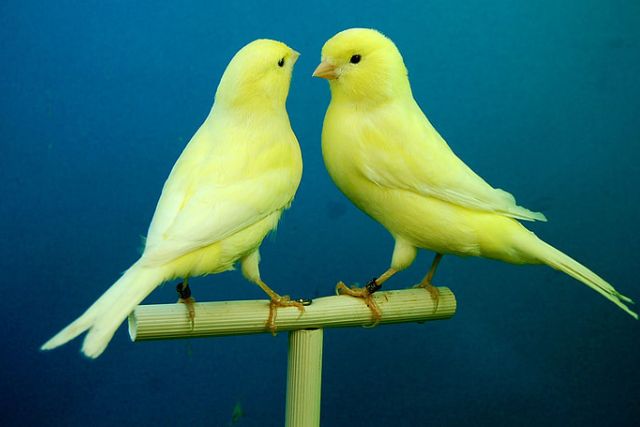There are many types of yellow birds in the world, but yellow birds often stand out as the most beautiful and eye-catching. Have you ever wondered why people are so drawn to them? Their vibrant color, unique behaviors, and charming songs make them truly special. From their striking plumage to their playful personalities, yellow birds capture attention like no other.
23 Types of Yellow Birds
Following are 23 types of yellow birds you should know.
1. American Goldfinch

The goldfinch is a small bird with a red face and yellow on its wings. It’s super friendly and often hangs out in groups, especially during nesting time. You can recognize it by its cheerful, twittering song. Goldfinches are pretty easy to spot in most places across North America just not in deep, dark forests.
2. Yellow-Headed Blackbird
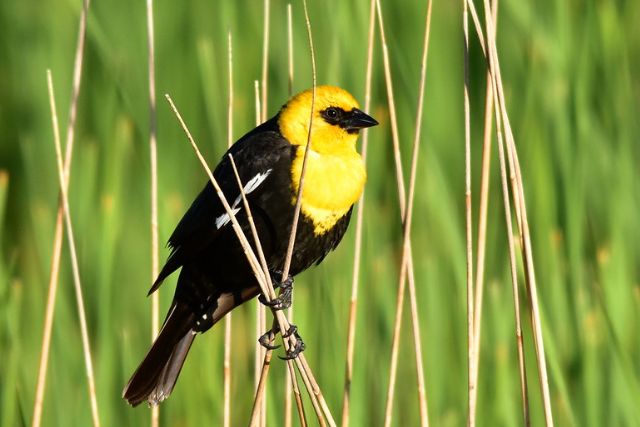
Yellow Headed Blackbird is one of the special and eye-catching bird. What makes it unique is its bright yellow head and chest, which really stand out against its shiny black body. They keep strong body, a long head, and a large, pointed beak. Male and female birds look different. The males are the ones with the bold yellow color, while females have duller colors and are a bit smaller.
3. Yellow wagtail
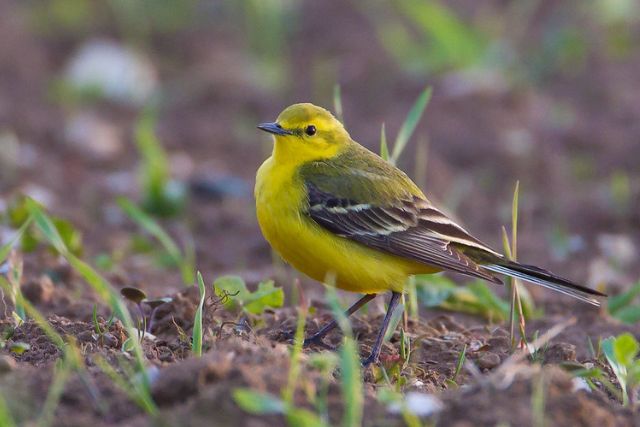
The Western Yellow Wagtail is a small, lively bird with a long tail that often bobs up and down just like it’s dancing! These birds breed across Europe and Asia. Most travel to tropical Africa and southern Asia for the winter. A small population in Egypt remains there all year.
4. Western Tanager
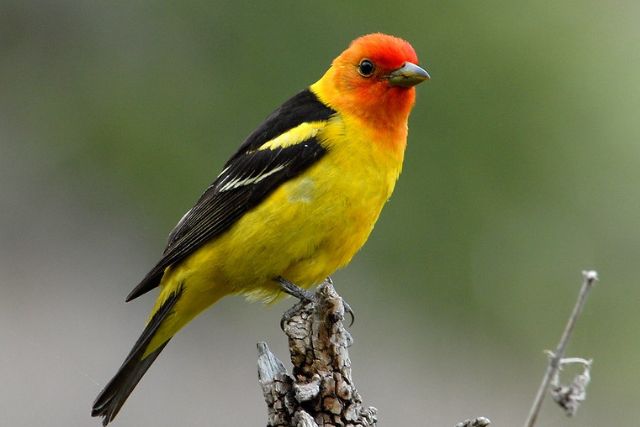
The Western Tanager is a colorful songbird that looks like a tiny flame! The male bird have a bright orange-red head, a yellow body, furthermore, they have black wings and tail. Females and young birds are more yellow-green with darker feathers. They stay in western woods, usually hiding up in tall trees.
You might hear their buzzy song or soft chuckling calls before you see them. The red on its head comes from a rare color called rhodoxanthin. Most red birds get their color from plants, but this bird gets it from insects! Males do a fun flight to impress females. They flip and show off their bright yellow and black feathers. One Western Tanager lived for almost 7 years in the wild.
5. Yellow Warbler

The yellow warbler is also one of the most beautiful types of yellow birds. The yellow warbler is one of the brightest and most widespread yellow birds in the Americas. This bird lives in many places like North America, the Caribbean, and parts of South America. Male birds in mating season are bright yellow with orange lines on their chest. Females and young birds are greenish-yellow with duller colors, especially on the head. They have black eyes, a narrow bill, and greenish wings with yellow borders. These small birds are not just pretty; they migrate long distances every year.
6. Pine Warbler

Pine warblers are little birds that live in pine woods in the eastern part of North America. Males are olive green with bright yellow throats. Females and young are duller with pale yellow chests. They have white bellies, two white wing bars, and yellowish circles around their eyes, making them easy to spot. They use their thin bills to eat insects, seeds, and berries, often visiting bird feeders in winter. These birds nest high in pine trees, laying 3 to 5 spotted white eggs in deep cup-shaped nests. Their soft trills and warm colors add life and sound to quiet woodlands.
7. Nashville Warbler
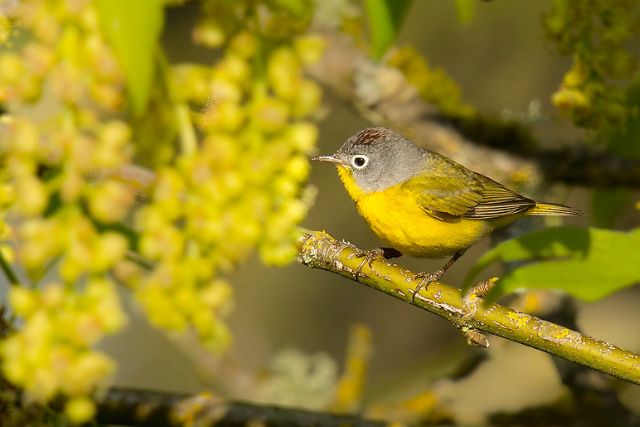
The Nashville Warbler is a small songbird found in North and Central America. It has a gray head, green back, and yellow underparts with a white belly. Both males and females look similar, but males have a hidden rusty patch on their crown. They have eye rings, plain wings, and a thin dark beak. Nashville Warblers breed in the U.S. and Canada and migrate to Mexico and Central America for winter. They are closely related to Virginia’s, Lucy’s, and Colima’s warblers.
8. Female Summer Tanager

The Summer Tanager is a bright bird found in North and Central America. It was first described in 1758. Males are all red. Females are yellow-orange with olive backs. They are about 17 cm long and weigh 30 grams. Their strong beaks help them eat insects and fruit. Their red and orange colors come from their food. The Summer Tanager sings a smooth, clear tune.
9. Audubon’s oriole
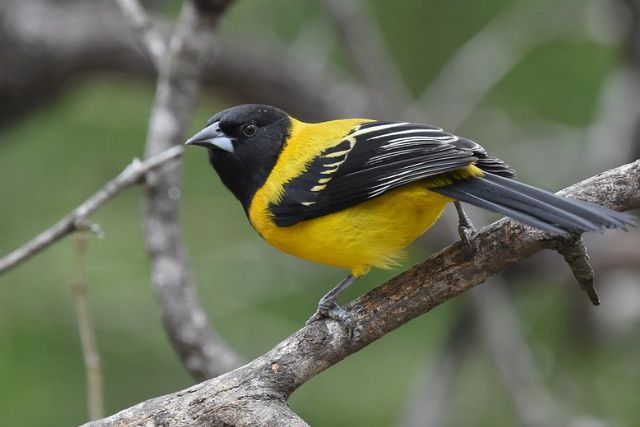
Audubon’s oriole is a colorful songbird found in forests and thickets of southeastern Texas and coastal Mexico. It’s the only oriole with a black hood and a bright yellow body. Males have black heads, wings, and tails, with white edges and yellow backs and bellies. Females look similar but are a bit duller with more olive on their backs.
10. Wilson’s Warbler
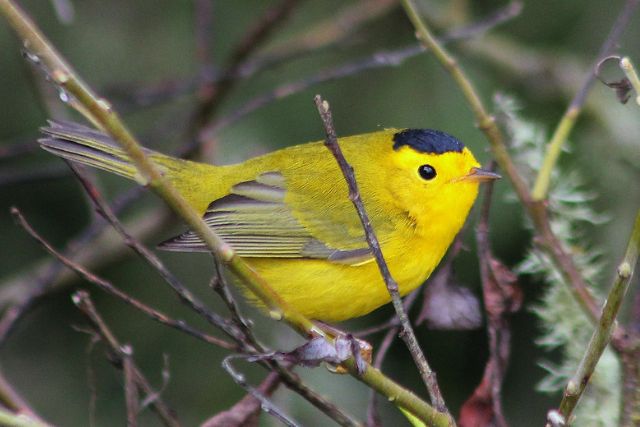
Wilson’s Warbler is a tiny, colorful bird known for its bright yellow body and lively personality. It breeds across Canada and parts of the western United States then travel south to Mexico and Central America for winter. Males are easy to recognize thanks to their bold black caps, while females are a bit plainer with either a smaller cap or none at all. They have olive-green backs, slim tails, and rounded wings, and unlike yellow warblers, they show no yellow on their wings or tails. Their cheerful, chattering song and sharp “chuff” call are often heard before the bird is even seen.
11. Magnolia Warbler
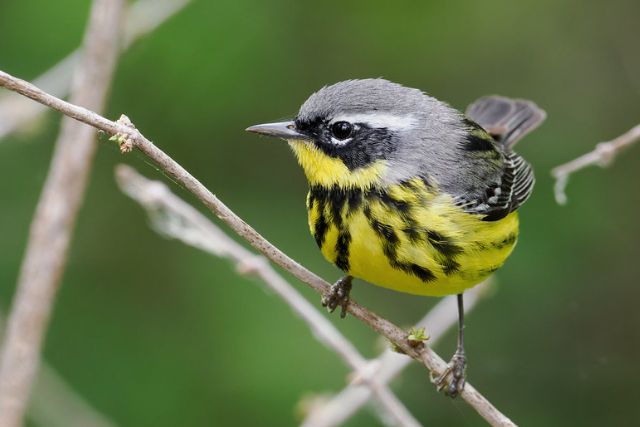
The Magnolia Warbler is a small, colorful bird, about 11–13 cm long and weighing around 6–12 grams. It breeds in dense northern forests across Canada and the northern U.S. (like Minnesota and Wisconsin). In winter, it migrates south to Mexico, Central America, and parts of the Caribbean. During migration, you can spot it in woodlands across the eastern United States. They love staying hidden among young, thick conifer trees. This bright little warbler is a true forest wanderer, traveling thousands of miles each year.
12. Townsend’s Warbler
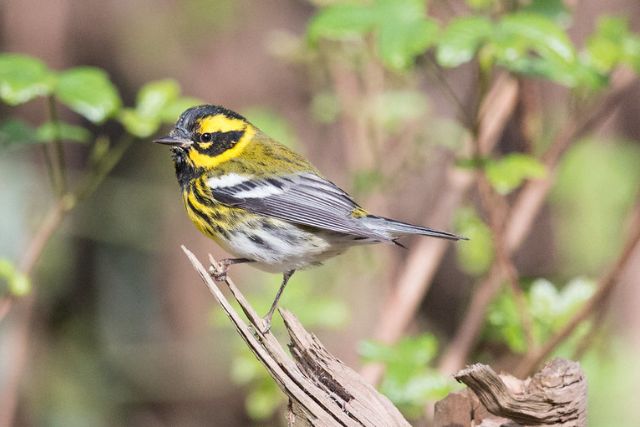
Townsend’s Warbler (Setophaga townsendi) was first described in 1837 by American naturalist John Kirk Townsend. This bird is one of the types of yellow birds, with its striking yellow face and black cheek stripe. Its olive upperparts are streaked with black, and it has two white wing bars and a white belly. Young male birds boast a black cap, black throat, and bright yellow chest, while ladies and young birds have darker caps and yellow throats. It primarily breeds in the Pacific Northwest. Now classified under the genus Setophaga, there are no recognized subspecies.
13. Palm Warbler
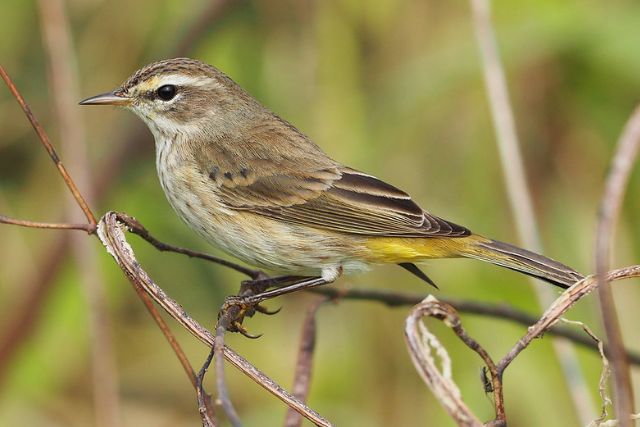
The Palm Warbler (Setophaga palmarum) includes two subspecies. Yellow Palm Warbler (Eastern): Bright yellow underparts with rich rufous streaks. Brown Palm Warbler (Western): Duller, gray-brown with faint yellow tones. They breed in open conifer bogs across Canada and the northeastern U.S. and migrate early to winter in the southeastern U.S., the Caribbean, and Central America. Their population has steadily grown between 1966 and 2015. Rare vagrants have even reached Iceland.
14. Yellow-Throated Vireo

The Yellow-Throated Vireo’s name means “yellow forehead” in Latin. It has a greenish back and a bright yellow neck. Its belly is white, and it has yellow “spectacles” around dark eyes. These small birds migrate every year to the southern U.S., Mexico, the Caribbean, and Central America. Some adventurous ones have even traveled all the way to Europe, which is rare but very exciting.
15. Hooded Warbler
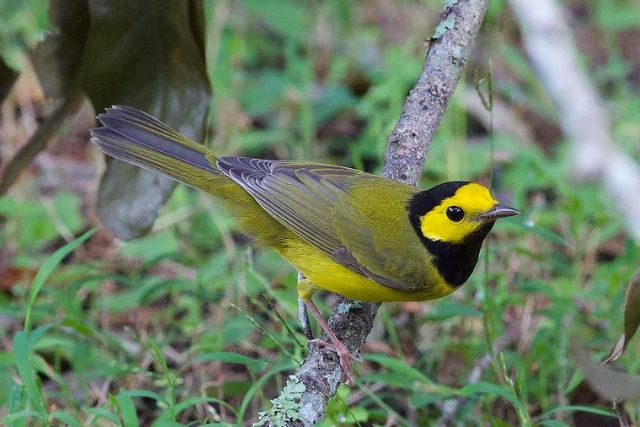
Would you like help rewriting more sentences like this? It has a bright yellow face and underparts with a bold black hood around its head, making it easy to spot! It breeds in the U.S. and Canada and migrates to Central America and the Caribbean for winter. This change reminds us how nature is full of surprising connections! Fun fact: it was first described in 1779 from a bird found in Louisiana. Protecting forests and wild spaces is important so amazing birds like this have safe places to live and migrate.
16. Prothonotary Warbler
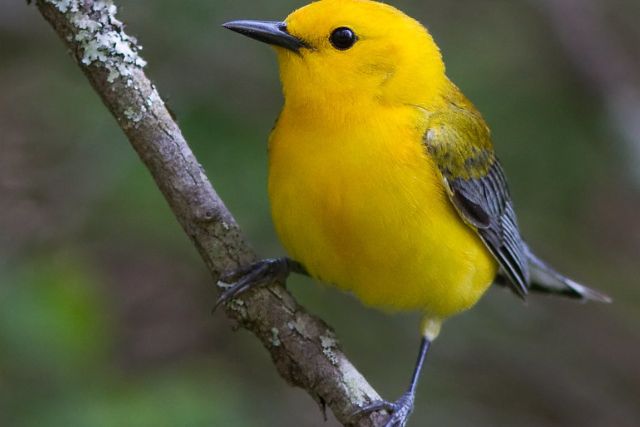
The prothonotary warbler is a beautiful, bright yellow songbird from North America. First described in 1779, it was named after church clerks (prothonotaries) who wore golden robes. It has an olive back, blue-gray wings, and a glowing orange-yellow head (especially in males). This small bird is about 13 cm (5.1 in) long and easily spotted by its two-toned tail when flying. As one of the types of yellow birds, it stands out for its vibrant coloration and unique features. It’s the only species in its genus, truly one of a kind.
17. Dickcissel
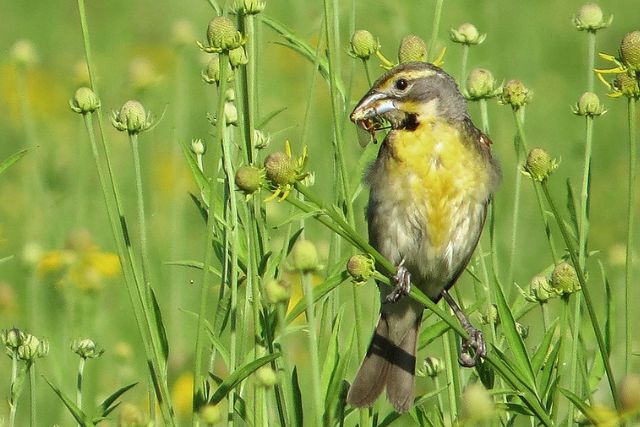
The Dickcissel is a small bird from the middle of the U.S. that eats seeds and is known for its happy song. It breeds in prairie grasslands and migrates to Central and South America for winter. The Dickcissel is a bright bird that looks like a sparrow. The male has a black throat and a yellow chest. It’s the only bird in its group called Spiza, which means “finch” in old Greek. A rare kind called “Townsend’s Dickcissel” has white feathers instead of yellow something special to see.
18. Common yellowthroat
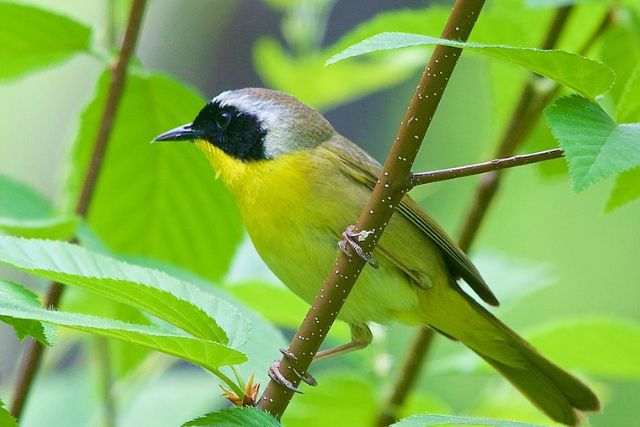
The common yellowthroat, also known as the Yellow Bandit, is a small, lively warbler found across North America, from Canada to Mexico. Male birds are easy to spot with their bright yellow throats and black masks on their faces. Female birds are lighter in color and don’t have the mask. There are 13 different types, mainly varying in how bright and bold the males look with southwestern birds showing the brightest yellow. These energetic songbirds love wetlands and grassy areas, often staying low to the ground.
19. Verdin
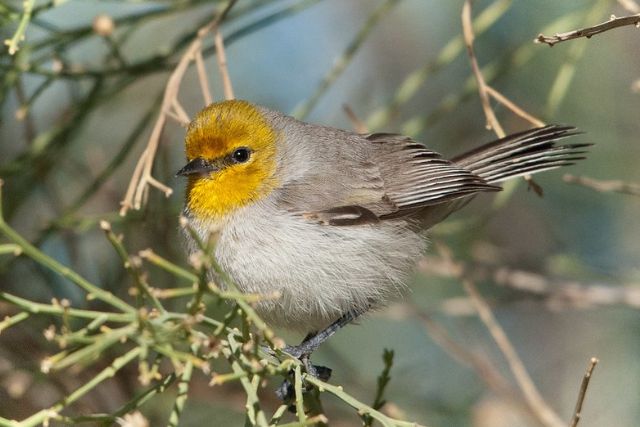
The Verdin is a tiny gray songbird with a bright yellow head and a rust-colored patch on its shoulder. It’s about 4.5 inches (11 cm) long, making it one of the smallest birds in North America. Unlike typical tits, it has a sharp, pointed bill. Juveniles are gray without a yellow head or shoulder patch. Verdins are the only North American member of the Old World Remizidae family and live mainly in deserts and scrublands of the southwest U.S. and Mexico.
20. Evening Grosbeak
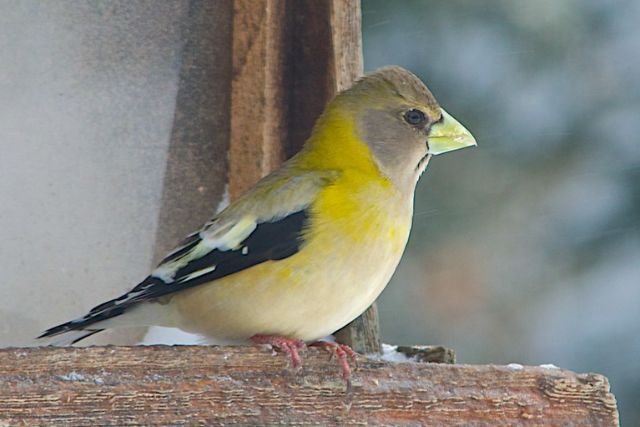
The Evening Grosbeak is a bright, chunky bird found in North America. Male birds are easy to spot with their bright yellow throats and black masks on their faces. Female birds are lighter in color and don’t have the mask. Both have big, pale beaks. They eat seeds, berries, and bugs. You can often spot them at bird tables during wintertime. Their name means “evening sound” because of their loud call. They don’t always migrate the same way every year. First described in 1825, they are one of the boldest types of yellow birds. They bring bright colors and cheerful sounds to the forest.
21. Scott’s oriole
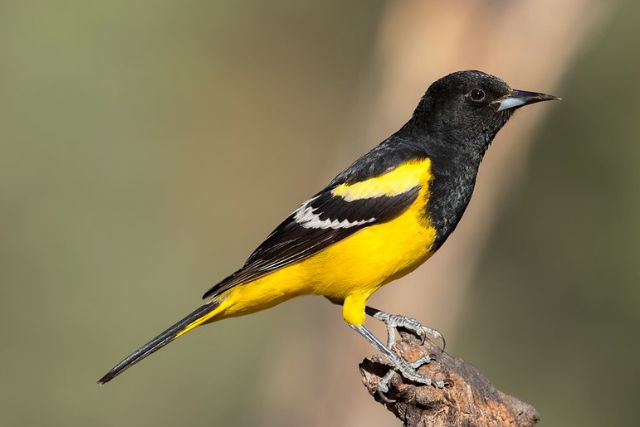
The Scott’s oriole is a bright yellow and black bird. It lives in the southwestern U.S. and Mexico. This bird likes dry, open areas with yucca plants. It is about 23 cm long and weighs around 32 to 41 grams. Males are black with yellow bellies; females are paler. Sometimes it travels far and is seen in eastern states. It was named in 1838, and some people now call it the Yucca Oriole. This bird sings a sweet, whistling song. It adds color and sound to desert landscapes. It is one of the most eye-catching types of yellow birds.
22. Firecrest
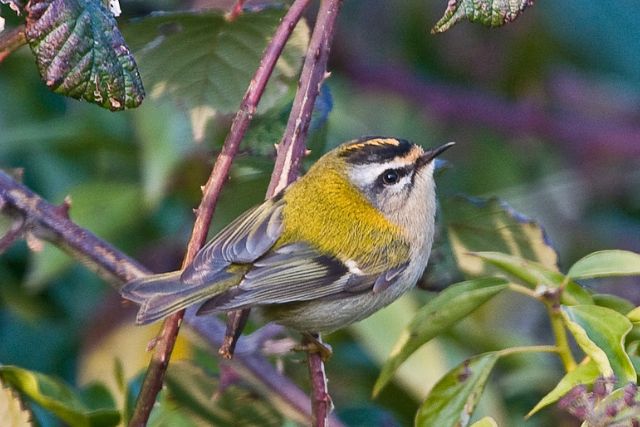
The Firecrest is a tiny bird, only 9 cm long and weighing just 6 grams. Its wingspan is about 14 cm. It looks like the goldcrest but has brighter colors. Males have a shiny orange top head with black sides. Females have a yellow crown. Both have a white line above the eye, which goldcrests do not have. Firecrests are olive-green above and pale below. They live in southern England, mostly in conifer forests. In winter, more come from Europe and can be seen in parks and gardens. Males have a shiny orange top head with black sides. Regulus ignicapilla means “little king with a fiery head,” showing the male’s bright crown.
23. Grey Wagtail
The Grey Wagtail is a thin bird around 18–19 cm long. It has a gray back and a yellow underside. Males get a black throat when nesting. It looks like the Yellow Wagtail but has less yellow. A clear white stripe above the eye and a yellow vent help identify it. This bird stays near moving water like rivers and creeks. It sometimes builds its nest on human-made things close to water. In winter, it can also be found near lakes, ponds, or coastal areas. Grey Wagtails often wag their tails and fly low in a bouncy way. They have a sharp, clear call and a song made of trills.
Related Reading: How to Keep Squirrels Out of Your Garden

